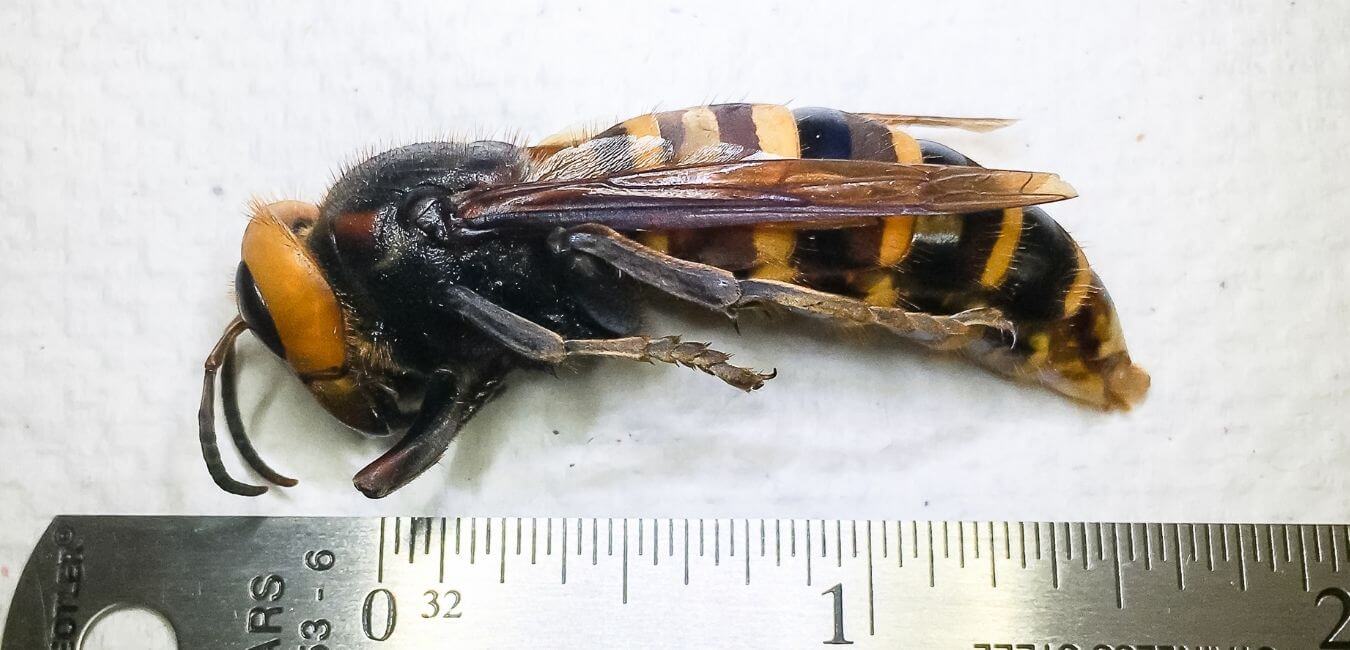The Asian giant hornet (Vespa mandarinia), also called the Asian Killer Hornet or Japanese giant hornet is the world’s largest hornet. It is native to temperate and tropical Southeast Asia, and parts of the Russian Far East. It is also found in the Pacific Northwest of North America as of late 2019, with additional sightings in 2020 and 2021, drawing concern that it could become an invasive species. In this article, we will discuss the topic of what do hornets eat.
What Does a Giant Asian Hornet Eat?
The Asian giant hornet is extremely predatory. It hunts medium- to large-sized insects, such as bees, other hornet species, and mantises. Asian giant hornets or killer hornets attack honey bee hives to get the adults, pupae, and larvae as food for their own larvae. They are sometimes known to cannibalize each other’s colonies. A single hornet can kill as many as 40 bees per minute due to its large mandibles or crushing jaws. Only a few hornets (less than 50) can exterminate a colony of tens of thousands of bees in a few hours.
Should You Be Afraid Of Japanese Killer Hornets?
Asian giant hornets, also known as Japanese killer hornets, “giant sparrow wasps,” or “murder hornets,” are very frightening. They are the largest hornet species in the world. Giant hornet workers can grow to be anywhere between 1 ½ inches to 2 inches. Giant hornet queens can exceed the 2-inch in length. Their wingspans commonly measure in at 3 inches. Wow!
The good news is that in most cases, the killer hornets will not show any aggression towards you if you don’t show any aggression towards them. Asian giant hornets were responsible for less than 13 deaths in Japan between 2017 and 2018. However, it’s best to always navigate with caution.
Still worried about the possibility of a hornet sting? Here are some things you can do to lower your odds of a killer hornet run-in:
- Asian giant hornets are attracted to dark colors. If you are roaming around a mountainous terrain or a forest full of foliage, stick to whites and pastels.
- Hornets are drawn to sweet smells. Leave the sodas, sugary snacks, and sweet-smelling perfumes at home.
- Avoid areas where tree sap is preset. Japanese killer hornets will always find their way to a sap-tapped tree.
Are killer hornets in the US?
A giant ‘murder hornet’ has just been found (June 2021) in a new part of the United States. The dead insect was discovered in a county of Washington state just north of Seattle by a member of the public in early June. DNA testing has since confirmed it is an Asian giant hornet or Vespa mandarinia.
Do killer hornets live in the ground?
Asian giant hornets nest in well-drained soil exposed to full sun. They often create large mounds of dirt. They can also be found in lawns or gardens. There’s only one wasp per burrow, but there are usually many burrows near each other.
What does a killer hornet’s nest look like?
A hornet’s nest is a paper-like structure created from hornets’ chewed wood. The size of the nest varies depending on the colony size, but it may be as huge as a basketball and appear to be built of a paper mache-like substance. The majority of nests are teardrop-shaped and have a single entrance. Nests are generally found in the sky or in extremely safe places.
How do you locate a hornet nest?
Follow the flight patterns of the hornets you can identify. As you approach closer to the nest, it will appear to be a little airport, with planes coming and departing. You might also try leaving a piece of fruit, a tray of sugar water, or a tiny piece of meat in areas where you have witnessed hornet activity. These objects, when used at the right time of year (late summer to early fall), may attract hornets and allow you to trace them back to the hive.
How long does it take for a killer hornet to kill you?
Since 2001, the yearly human death toll caused by stings of bees, wasps, and hornets in Japan has been ranging between 12 and 26. Since this number also includes deaths caused by bees, wasps, and other hornet species, the number of deaths caused by Asian giant hornets is likely to be much lower.
Medical advice given in China states that people stung more than 10 times should seek medical help, and require emergency treatment for more than 30 stings. The stings can potentially cause kidney failure. In 2013, stings by Asian giant hornets killed 41 people and injured more than 1,600 people in Shaanxi, China.

